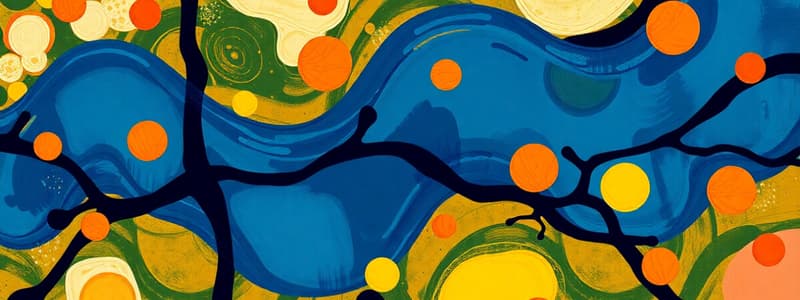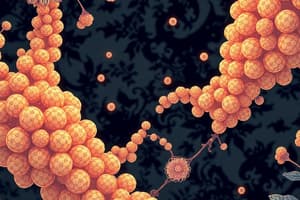Podcast
Questions and Answers
What is the effect of a cis double bond on a hydrocarbon chain?
What is the effect of a cis double bond on a hydrocarbon chain?
- It straightens the chain, making it more rigid.
- It introduces a kink, making the chain less linear. (correct)
- It increases the chain's ability to pack tightly together.
- It has no significant effect on the chain's structure.
How does the packing of unsaturated fatty acids compare to saturated fatty acids?
How does the packing of unsaturated fatty acids compare to saturated fatty acids?
- Saturated fatty acids pack more tightly due to their linear structure.
- Unsaturated fatty acids pack more loosely due to their kinks. (correct)
- Unsaturated fatty acids pack more tightly due to their increased rigidity.
- Both types of fatty acids pack equally tightly.
Which type of fatty acid has a higher melting point?
Which type of fatty acid has a higher melting point?
- Both types have equal melting points.
- Saturated fatty acid (correct)
- Unsaturated fatty acid
- The melting point depends on the specific fatty acid, not its saturation level.
Why do unsaturated fatty acids have lower melting points compared to saturated fatty acids?
Why do unsaturated fatty acids have lower melting points compared to saturated fatty acids?
What are triacylglycerols composed of?
What are triacylglycerols composed of?
What is the main characteristic of the phospholipid head that allows it to interact with the aqueous environment?
What is the main characteristic of the phospholipid head that allows it to interact with the aqueous environment?
Where can the hydrophilic head of a phospholipid be found in a cell membrane?
Where can the hydrophilic head of a phospholipid be found in a cell membrane?
Which of the following statements best describes the interaction of the hydrophilic head of a phospholipid with the aqueous environment?
Which of the following statements best describes the interaction of the hydrophilic head of a phospholipid with the aqueous environment?
Which of the following is NOT a consequence of the hydrophilic head of a phospholipid interacting with the aqueous environment?
Which of the following is NOT a consequence of the hydrophilic head of a phospholipid interacting with the aqueous environment?
What is the main difference between sphingomyelins and ceramides?
What is the main difference between sphingomyelins and ceramides?
What is a primary effect of these compounds on the body?
What is a primary effect of these compounds on the body?
Which of the following statements about sphingomyelins is TRUE?
Which of the following statements about sphingomyelins is TRUE?
Which of the following is a direct consequence of these compounds blocking thromboxane formation?
Which of the following is a direct consequence of these compounds blocking thromboxane formation?
What is the function of the polar head group in sphingomyelins?
What is the function of the polar head group in sphingomyelins?
What type of molecules are prostaglandins?
What type of molecules are prostaglandins?
What is the primary cellular target of these compounds in relation to blood clotting?
What is the primary cellular target of these compounds in relation to blood clotting?
What is the primary structural difference between ceramides and sphingomyelins?
What is the primary structural difference between ceramides and sphingomyelins?
Which of the following is a characteristic of phospholipids like sphingomyelins?
Which of the following is a characteristic of phospholipids like sphingomyelins?
What is the main mechanism by which these compounds exert their effects?
What is the main mechanism by which these compounds exert their effects?
What is the primary cause of rancidity in unsaturated fatty acids?
What is the primary cause of rancidity in unsaturated fatty acids?
Which of the following is NOT a characteristic of biological waxes?
Which of the following is NOT a characteristic of biological waxes?
What is the primary property that allows phospholipids to form bilayers?
What is the primary property that allows phospholipids to form bilayers?
What is the typical carbon chain length range for fatty acids found in biological waxes?
What is the typical carbon chain length range for fatty acids found in biological waxes?
What is a major functional difference between biological waxes and triglycerides?
What is a major functional difference between biological waxes and triglycerides?
Which of the following is NOT a component of a phospholipid molecule?
Which of the following is NOT a component of a phospholipid molecule?
What is the primary role of the hydrophobic interactions between phospholipid molecules?
What is the primary role of the hydrophobic interactions between phospholipid molecules?
Which of the following is a TRUE statement about the relationship between rancidity and waxes?
Which of the following is a TRUE statement about the relationship between rancidity and waxes?
Which of the following best describes the arrangement of phospholipids in a bilayer?
Which of the following best describes the arrangement of phospholipids in a bilayer?
Which of the following is TRUE about the hydrophilic interactions between phospholipids and water?
Which of the following is TRUE about the hydrophilic interactions between phospholipids and water?
What is the primary cause of thiamine deficiency in the United States, according to the passage?
What is the primary cause of thiamine deficiency in the United States, according to the passage?
Which of the following is NOT a sign of infantile beriberi?
Which of the following is NOT a sign of infantile beriberi?
What are the two biologically active coenzyme forms of niacin?
What are the two biologically active coenzyme forms of niacin?
What is the primary function of NAD+ and NADP+ in the body?
What is the primary function of NAD+ and NADP+ in the body?
Which of the following is NOT a symptom of pellagra?
Which of the following is NOT a symptom of pellagra?
What is the main dietary source of niacin?
What is the main dietary source of niacin?
What is the characteristic symptom of Wernicke-Korsakoff syndrome that involves the eyes?
What is the characteristic symptom of Wernicke-Korsakoff syndrome that involves the eyes?
Which of the following is TRUE about the reduced forms of NAD+ and NADP+?
Which of the following is TRUE about the reduced forms of NAD+ and NADP+?
Which of the following symptoms is NOT directly related to the deficiency in the hydroxylation of collagen caused by a lack of ascorbic acid?
Which of the following symptoms is NOT directly related to the deficiency in the hydroxylation of collagen caused by a lack of ascorbic acid?
What is the primary role of Vitamin C in the absorption of iron from the intestine?
What is the primary role of Vitamin C in the absorption of iron from the intestine?
Which of the following statements is TRUE about the association between Vitamin C and chronic diseases?
Which of the following statements is TRUE about the association between Vitamin C and chronic diseases?
What is the main reason why a deficiency in ascorbic acid leads to defective connective tissue?
What is the main reason why a deficiency in ascorbic acid leads to defective connective tissue?
What is the relationship between Vitamin C and anemia in the context of scurvy?
What is the relationship between Vitamin C and anemia in the context of scurvy?
Which of the following is a symptom of riboflavin deficiency?
Which of the following is a symptom of riboflavin deficiency?
What is the primary function of biotin in the body?
What is the primary function of biotin in the body?
Why is biotin deficiency not commonly seen in humans?
Why is biotin deficiency not commonly seen in humans?
What is the main structural difference between the porphyrin ring and the corrin ring in vitamin B12?
What is the main structural difference between the porphyrin ring and the corrin ring in vitamin B12?
What is the main role of pantothenic acid in the body?
What is the main role of pantothenic acid in the body?
What is the main function of ascorbic acid (vitamin C) in the body?
What is the main function of ascorbic acid (vitamin C) in the body?
Which of the following is NOT a characteristic of the cobalamin molecule?
Which of the following is NOT a characteristic of the cobalamin molecule?
What is the primary role of cobalamin in the body?
What is the primary role of cobalamin in the body?
What is the consequence of adding raw egg white to the diet?
What is the consequence of adding raw egg white to the diet?
What is a potential consequence of cobalamin deficiency?
What is a potential consequence of cobalamin deficiency?
Which of the following is NOT a characteristic of pantothenic acid deficiency?
Which of the following is NOT a characteristic of pantothenic acid deficiency?
Which of the following statements is TRUE regarding the role of vitamin C (ascorbic acid) in collagen synthesis?
Which of the following statements is TRUE regarding the role of vitamin C (ascorbic acid) in collagen synthesis?
Which of the following is a coenzyme form of cobalamin?
Which of the following is a coenzyme form of cobalamin?
What factor limits the maximum recommended intake of folic acid?
What factor limits the maximum recommended intake of folic acid?
What is the main source of vitamin B12 for humans?
What is the main source of vitamin B12 for humans?
What is the estimated daily intake of folic acid from enriched grain products?
What is the estimated daily intake of folic acid from enriched grain products?
What condition can result from a deficiency of Vitamin D3?
What condition can result from a deficiency of Vitamin D3?
Which step is NOT involved in the conversion of Vitamin D3 to its active form?
Which step is NOT involved in the conversion of Vitamin D3 to its active form?
What is the primary role of retinoic acid in the body?
What is the primary role of retinoic acid in the body?
What immediate symptom indicates a deficiency in Vitamin A?
What immediate symptom indicates a deficiency in Vitamin A?
Which form of Vitamin D is most abundant in the circulatory system?
Which form of Vitamin D is most abundant in the circulatory system?
What process increases the visual threshold, making it difficult to see in dim light?
What process increases the visual threshold, making it difficult to see in dim light?
In what part of the body does the first step of Vitamin D3 activation occur?
In what part of the body does the first step of Vitamin D3 activation occur?
Which vitamin is essential for the maintenance of epithelial tissues and vision?
Which vitamin is essential for the maintenance of epithelial tissues and vision?
What is the most active compound in Vitamin E?
What is the most active compound in Vitamin E?
Which deficiency is most commonly associated with Vitamin E?
Which deficiency is most commonly associated with Vitamin E?
What is a potential consequence of reduced bacterial populations in the gut concerning Vitamin K?
What is a potential consequence of reduced bacterial populations in the gut concerning Vitamin K?
Which of the following vitamins is primarily associated with blood clotting?
Which of the following vitamins is primarily associated with blood clotting?
What is the primary function of Vitamin E as an antioxidant?
What is the primary function of Vitamin E as an antioxidant?
What symptoms might indicate a deficiency of Vitamin E in an individual?
What symptoms might indicate a deficiency of Vitamin E in an individual?
What type of vitamin often serves as precursors for coenzymes in metabolism?
What type of vitamin often serves as precursors for coenzymes in metabolism?
Which of the following conditions is most frequently seen in children due to vitamin A deficiency?
Which of the following conditions is most frequently seen in children due to vitamin A deficiency?
Flashcards
Cis double bond
Cis double bond
A double bond in fatty acids that causes a kink in the hydrocarbon chain.
Unsaturated fatty acids
Unsaturated fatty acids
Fatty acids with one or more double bonds, causing them to be less ordered.
Melting points
Melting points
The temperature at which a substance turns from solid to liquid.
Triacylglycerols
Triacylglycerols
Signup and view all the flashcards
Thermal energy and disorder
Thermal energy and disorder
Signup and view all the flashcards
Hydrophilic head of phospholipid
Hydrophilic head of phospholipid
Signup and view all the flashcards
Aqueous environment
Aqueous environment
Signup and view all the flashcards
Phospholipid structure
Phospholipid structure
Signup and view all the flashcards
Intracellular interaction
Intracellular interaction
Signup and view all the flashcards
Extracellular environment
Extracellular environment
Signup and view all the flashcards
Rancidity
Rancidity
Signup and view all the flashcards
Fatty acid cleavage
Fatty acid cleavage
Signup and view all the flashcards
Biological waxes
Biological waxes
Signup and view all the flashcards
Long-chain alcohols
Long-chain alcohols
Signup and view all the flashcards
Amphipathic
Amphipathic
Signup and view all the flashcards
Membrane bilayer
Membrane bilayer
Signup and view all the flashcards
Phospholipids
Phospholipids
Signup and view all the flashcards
Hydrophobic interactions
Hydrophobic interactions
Signup and view all the flashcards
Hydrophilic interactions
Hydrophilic interactions
Signup and view all the flashcards
Ceramide
Ceramide
Signup and view all the flashcards
Sphingomyelins
Sphingomyelins
Signup and view all the flashcards
Polar group
Polar group
Signup and view all the flashcards
Lipid structure
Lipid structure
Signup and view all the flashcards
Prostaglandins
Prostaglandins
Signup and view all the flashcards
Thromboxane
Thromboxane
Signup and view all the flashcards
Inhibition of prostaglandins
Inhibition of prostaglandins
Signup and view all the flashcards
Antipyretic effect
Antipyretic effect
Signup and view all the flashcards
Anticoagulant effect
Anticoagulant effect
Signup and view all the flashcards
Vitamin D
Vitamin D
Signup and view all the flashcards
Vitamin D3
Vitamin D3
Signup and view all the flashcards
Active form of Vitamin D
Active form of Vitamin D
Signup and view all the flashcards
Vitamin A (Retinol)
Vitamin A (Retinol)
Signup and view all the flashcards
Night blindness
Night blindness
Signup and view all the flashcards
Retinoic acid
Retinoic acid
Signup and view all the flashcards
Rickets disease
Rickets disease
Signup and view all the flashcards
Vitamin D activation process
Vitamin D activation process
Signup and view all the flashcards
Xerophthalmia
Xerophthalmia
Signup and view all the flashcards
Deficiency of Vitamin E
Deficiency of Vitamin E
Signup and view all the flashcards
Deficiency of Vitamin K
Deficiency of Vitamin K
Signup and view all the flashcards
Water-soluble vitamins
Water-soluble vitamins
Signup and view all the flashcards
Role of Vitamin A
Role of Vitamin A
Signup and view all the flashcards
Role of retinoic acid
Role of retinoic acid
Signup and view all the flashcards
Folic Acid Supplementation
Folic Acid Supplementation
Signup and view all the flashcards
Upper Limit of Folic Acid Intake
Upper Limit of Folic Acid Intake
Signup and view all the flashcards
Vitamin B12 Functions
Vitamin B12 Functions
Signup and view all the flashcards
Consequences of B12 Deficiency
Consequences of B12 Deficiency
Signup and view all the flashcards
Structure of Cobalamin
Structure of Cobalamin
Signup and view all the flashcards
Cobalamin Sources
Cobalamin Sources
Signup and view all the flashcards
Vitamin B12 and Neurology
Vitamin B12 and Neurology
Signup and view all the flashcards
Methylmalonyl CoA
Methylmalonyl CoA
Signup and view all the flashcards
Infantile beriberi signs
Infantile beriberi signs
Signup and view all the flashcards
Wernicke-Korsakoff syndrome
Wernicke-Korsakoff syndrome
Signup and view all the flashcards
Niacin
Niacin
Signup and view all the flashcards
NAD+
NAD+
Signup and view all the flashcards
Pellagra
Pellagra
Signup and view all the flashcards
Sources of Niacin
Sources of Niacin
Signup and view all the flashcards
Symptoms of Wernicke-Korsakoff
Symptoms of Wernicke-Korsakoff
Signup and view all the flashcards
NADH
NADH
Signup and view all the flashcards
Riboflavin deficiency symptoms
Riboflavin deficiency symptoms
Signup and view all the flashcards
Function of Biotin
Function of Biotin
Signup and view all the flashcards
Biotin deficiency sources
Biotin deficiency sources
Signup and view all the flashcards
Pantothenic acid role
Pantothenic acid role
Signup and view all the flashcards
Sources of Pantothenic acid
Sources of Pantothenic acid
Signup and view all the flashcards
Ascorbic Acid function
Ascorbic Acid function
Signup and view all the flashcards
Symptoms of Biotin deficiency
Symptoms of Biotin deficiency
Signup and view all the flashcards
Riboflavin significance
Riboflavin significance
Signup and view all the flashcards
Vitamin C purpose
Vitamin C purpose
Signup and view all the flashcards
Scurvy
Scurvy
Signup and view all the flashcards
Antioxidants
Antioxidants
Signup and view all the flashcards
Diet rich in Vitamin C
Diet rich in Vitamin C
Signup and view all the flashcards
Iron absorption
Iron absorption
Signup and view all the flashcards
Study Notes
Dietary Lipids Metabolism
- The average daily lipid intake for US adults is about 81g, with over 90% being triacylglycerol (TAG).
- The remainder of dietary lipids consists primarily of cholesterol, cholesteryl esters, phospholipids, and free fatty acids.
Lipid Structure
- Lipids are categorized based on solubility.
- Storage lipids (neutral):
- Triacylglycerols (TAG): Three fatty acids linked to glycerol.
- Membrane lipids (polar):
- Glycerophospholipids: Fatty acids, phosphate, and an alcohol are linked to glycerol.
- Sphingolipids: Sphingosine, fatty acid, and a polar head group(like phosphocholine or carbohydrate).
- Glycolipids: Sphingosine, fatty acid, and carbohydrate.
- Cholesterol: A steroid with a hydroxyl group and a four ring structure.
Fatty Acids
- Fatty acids(FA) are carboxylic acids with long hydrocarbon chains (4-36 carbons).
- The most abundant are 16- and 18- carbons long.
- They can be saturated (no double bonds) or unsaturated (double bonds in cis configuration).
- Naming conventions include the delta system (numbering from the carboxyl end) and the omega system (numbering from the methyl end).
- Saturated fatty acids generally have higher melting points than unsaturated fatty acids.
Lipid Classification
- Storage lipids: Triacylglycerols (TAG), Fats, Oils and Waxes, which are energy storage forms.
- Structural lipids: Glycerophospholipids, Sphingolipids, Sterols, which form biological membranes.
- Signaling, cofactor and pigment lipids: Phosphatidylinositols, Eicosanoids, Prostaglandins, Thromboxanes, Leukotrienes, steroid hormones, Vitamins A, D, E, K.
Triglycerides
- Triglycerides are triesters of glycerol (glycerol + 3 fatty acids).
- Two types: Simple (all three fatty acids are the same) and Mixed (different fatty acids).
Phospholipids
- Phospholipids are polar molecules with a hydrophilic head and hydrophobic tails.
- They are important components of cell membranes.
- Important examples include phosphatidylcholine, phosphatidylethanolamine, and phosphatidylserine.
- Phospholipids are also involved in signal transduction (e.g., Phosphatidylinositol).
Sphingolipids
- Sphingolipids are composed of sphingosine, a fatty acid, and a polar head group (e.g., phosphocholine or carbohydrate).
- Key examples include ceramides, sphingomyelins, cerebrosides, and gangliosides.
Glycolipids
- Glycolipids are a subclass of sphingolipids with a carbohydrate attached to the polar head group.
- Cerebrosides and gangliosides are crucial components of the nervous system.
Steroids
- Steroids are lipids with a four-ring structure.
- Cholesterol is a vital component of animal cell membranes and a precursor for steroid hormones (like cortisol, estrogen, testosterone).
- Other sterols (i.e., erosterol and stigmasterol) are found in other organisms
Eicosanoids
- These derivatives of polyunsaturated fatty acids (like arachidonic acid) play roles in inflammation, pain, fever, blood clotting, smooth muscle contraction (e.g., uterus and intestines), and blood vessel diameter.
- Prostaglandins, thromboxanes, and leukotrienes are types of Eicosanoids.
Biological roles of lipids (including steroids and eicosanoids).
- Energy storage and transport
- Membrane structure and function
- Signaling molecules
- Vitamins A, D, E, and K.
- Cellular signaling
Studying That Suits You
Use AI to generate personalized quizzes and flashcards to suit your learning preferences.




